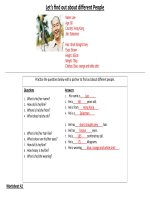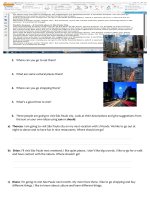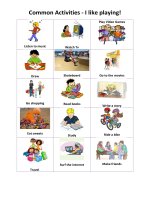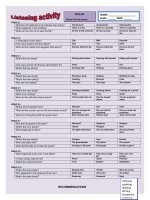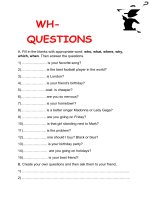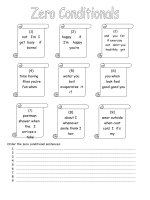islcollective worksheets beginner prea1 elementary a1 preintermediate a2 intermediate b1 upperintermediate b2 advanced c 417028796576927df668d79 53025737
Bạn đang xem bản rút gọn của tài liệu. Xem và tải ngay bản đầy đủ của tài liệu tại đây (78.72 KB, 4 trang )
COMPLETE PRESENT TENSE VERBS REVIEW
Present Continuous
Continuous/Progressive verbs are used to define ‘something which is happening at a certain moment in
time’
Verb construction of this present tense
AFFIRMATIVE: Subject + am/are/is + verb in ‘ing’
• I am cooking dinner.
She is sitting on a chair.
The children are playing in the garden.
NEGATIVE: Subject + am/are/is + not (n’t) + verb in ‘ing’
• I’m not working today.
John isn’t doing his homework.
You are not going without me!
QUESTION: Am/Are/Is + subject + verb in ‘ing’.
• Am I doing the right thing? Is Mary doing her homework? Are they playing tennis?
Are you coming with me? Are you listening to me?
Is the dog eating its food?
This verb construction in the present tense is used :
With action verbs (we can see this thing/action being done.)
• John is playing the piano. They are listening to classical music. (‘ To listen’ - action verb
associated with one of our senses)
With verbs with more than one meaning to represent movement/action
• John thinks that Mary is beautiful. (This is his opinion – verb of state of mind – Simple present)
• John is thinking of visiting New York. (His mind is elaborating this thought – action)
With ‘always’ to represent something we disapprove of
• John smokes a lot. (This is a truth/fact. We use the simple present.)
• John is always smoking. (We do not approve. This action troubles us a lot)
In the present, action is associated with adverbs of the present time: –now – at the moment – today – still
I can’t come with you. I am still doing my homework.
I’m watching TV at the moment.
Modals + semi-modals
These verbs are used to express possibility, intention, obligation, necessity, asking for permission, making
requests, offering something, offering to do something. They change our perception of the verb they are
linked to.
• I clean my bedroom once a week. (This is a fact. – Simple present tense)
• I must/have to clean my bedroom once a week. (I feel obliged/someone makes me do this)
Verb construction in the present tense
AFFIRMATIVE: Subject + modal/semi-modal + base form principal verb
• I can swim. (‘can’ here is used for ability) I can come with you. (This is possible/permitted)
NEGATIVE: Subject + modal/semi-modal + not (n’t) + base form principal verb
• I can’t play tennis. (no ability)
He can’t go to school today. (not possible)
QUESTION: Modal/semi-modal + subject + base form principal verb
• Would you like a cup of tea? (offering something)
• Would you like me to help you? (offering to do something)
• Must I come with you immediately? Do I have to come with you immediately? (obligation)
• Need I come with you? (Is it necessary?)
• Can I/May I/Could I leave the room, please? (asking permission – different levels of formality)
• You cannot/mustn’t smoke in this room. (It is not permitted. It is prohibited)
• Can I go to the park with my friends? Yes, you can. (asking/giving permission)
Uses of verb ‘to be’ in the present tense
The verb ‘to be’ in the simple present is a verb of state. It is used for facts/truths
Verb construction in the present tense
AFFIRMATIVE: subject + am/are/is + remaining part of sentence.
• I am late for work. You are very friendly. John is tall. Mary is beautiful. It is hot, today. We
are young. These are our friends John and Mary Brown.
NEGATIVE: Subject – am/are/is + not (n’t) + remaining part of sentence.
• I’m not late this morning. You aren’t very friendly. It isn’t hot. Those shoes aren’t yours.
QUESTION: Am/Are/Is + subject + remaining part of sentence.
• Am I late? Yes, you are.
Is Mary a student at Birmingham university? Yes, she is.
Are those books John’s? No, they aren’t.
COMBINED WITH A QUESTION WORD: (Interrogative adverbs)
• How tall is John? He is 5’8”. (How + adjective)
• What is he like? (tell me something about his character). He is very kind.
• Who is she? She is my sister. (Who is subject, but with be + noun/pronoun, the standard
interrogative form is used).
• Whose book is this? Whose is this? It’s Mary’s (book). (Whose is the indicator of
possession/subject of the sentence)
• Who are you with? I am with my sister. (Who is object pronoun and uses the standard
interrogative form)
‘Be’ combined with a past participle is used to form the present tense passive voice .
•
They are building a hotel in the village. (Present Continuous – this is happening)
A bridge is being built in the village. (someone is building it. The object have become the subject
of the sentence because the bridge is more important than the people building it) – Passive form of the
present Continuous.
• They produce computers in this factory. (Simple present)
Computers are produced in this factory. (Passive form of the simple present)
Simple present of verb ‘have got’
We use ‘have got’ to talk about situations or state. It indicates possession, relationship, qualities or
features. It is considered informal and is not commonly used in written English. Its use is very common in
spoken British English but is less common in American English. It is not usually used in any tense other
than the present. The abbreviated form of ‘have’ is usually used.
AFFIRMATIVE: Subject + have got/has got + remaining part of sentence
• I’ve got two brothers.
Mary’s got a headache.
We’ve got plenty of time.
The Simpsons have got a new car. John has got/John’s got a bad temper.
NEGATIVE: Subject + haven’t got/hasn’t got + remaining part of sentence
• They haven’t got a big house. John hasn’t got a sister. It hasn’t got a good reputation.
I haven’t got backache. Susan hasn’t got time to wash her car today.
QUESTION: Have/Has + subject + got + remaining part of sentence
• Have you got any brothers or sisters? Yes, I have. I’ve got one brother and two sisters.
Has he got time to help us? No, he hasn’t.
Has it got two drawers or three? It’s got two.
All other ‘simple’ verbs used to indicate the present time
‘Simple’ tenses are formed by using the base form of the principal verb. In the present tense the auxiliary
verb ‘do/does’ is used. In the affirmative the third person singular always finishes in ‘s’.
The ‘simple’ verb construction is used to express habits, general truths, facts, repeated actions,
unchanging situations, emotions, the senses
Adverbs of frequency are often used with ‘simple’ verbs: always – frequently - occasionally - often,
sometimes - usually - every
‘Regular verbs’ construction in the present tense
AFFIRMATIVE: subject + base form verb + (s/es/ies in the 3 rd person singular only) + remaining part of
sentence.
• I play tennis every Friday. They produce wine in Italy.
He lives with his parents.
Mr Brown teaches English. John studies French at university. Mary has breakfast at 7.30.
NEGATIVE: Subject + don’t/doesn’t + base form verb + remaining part of sentence.
• We don’t come from Spain. I don’t live in Rimini.
They don’t often go to the cinema.
It doesn’t work.
Alberto doesn’t eat fish.
She doesn’t have lunch at 12.00
QUESTION: Do/Does + subject + base form of verb + remaining part of sentence
• Do you live in Italy?
Does John live in Birmingham? Do they work in a factory?
Does it work?
Do you like chocolate? Yes, I do. No, I don’t.
COMBINED WITH A QUESTION WORD: (Interrogative adverbs)
• What do you do? I’m a teacher.
Where do you live? How does he get to work?
• Who takes private English lessons? (Who is subject – affirmative verb construction) – Mary takes
private lessons.
• Who meets you every Sunday?
(Who is subject – affirmative verb construction) – John meets
me every Sunday.
• Who do you meet every Sunday? (who is object – interrogative verb construction) – I meet John
every Sunday.
• Whose bicycle needs repairing? (whose is subject – affirmative verb construction)
• Whose (umbrella) can I borrow? (whose is object – interrogative verb construction)
Imperative mood
We use the imperative: to give a direct order, to give instructions, to make an invitation, on signs and
noticeboards, to give friendly advice.
Construction of the second person imperative:
AFFIRMATIVE: The base form of the verb is used. The subject is not expressed.
• Sit Down! Shut up! Be quiet! (commands)
Construction of the first and third person imperative:
• Let me sit down! Let him/her sit down! Let us sit down! (speaking to someone who is not part of
the ‘us’ group) - requests
• Let’s sit down. (speaking to the members of the ‘us’ group of people) - Suggestion
NEGATIVE: Don’t + base form of verb + remaining part of sentence.
• Don’t behave so badly! Don’t go there!
Don’t touch that dog! Don’t drive so fast!
• But we usually say – Let’s not go to the cinema rather than Don’t let’s go to the cinema.
•
•
•
•
Come to our party with John! – invitation
Beware of the dog! – warning sign
Do be careful. – friendly advice
Turn left at the traffic lights then go past the supermarket. (giving instructions)
I have put this together because I could find no similar review anywhere.
I have purposely put the regular present simple verbs towards the end because we only find this auxiliary
construction in the simple present and the simple past. All other constructions invert subject and verb/
first verb in compound verbs to form questions and we just add ‘not’ to the first verb to form a negative
sentence.
•
•
Am I . . . ?
I’m not
Would you . . .? Have you seen . . . ? Have you got . . . ? Will you be . . . ? etc.
You wouldn’t
You haven’t seen You have got
You will be
I have found that students who are taught regular simple verbs at an early stage, tend to think that the use
of ‘do/does/did’ as an auxiliary is the most common form of constructing questions and negative
sentences.
Teaching the present continuous at a very early stage reinforces the idea of ‘-ing’ = action , introduces
students to the verb ‘be’ at the same time and establishes the idea that the inversion of subject /verb is the
most common construction for questions.
Please, if I have left anything out, or made any mistakes (typos or otherwise) tell me on my recommend
page. If you have any suggestions to better any of my worksheets I would be very grateful.
Best wishes from Italy to all of you
lesleymisano



